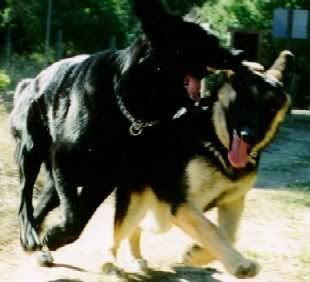
This is a placeholder text
Group text
by Pharaoh on 05 October 2010 - 18:10
Ibrahim,
This is my first GSD. He was totally deep solid black. He is also the dog that had a reddish tinge appear on parts of his body. Someone told me that can be nutrition. I switched him to raw food a 5 years old. I don't think it was the sun because he really liked sun bathing and it never reappeard again. He was 13 when he died but he did not get any white on his muzzle till he was twelve. He was a great big wonderful dog.



The group picture was at his 2nd birthday party in 1995. The two big girls on either side of him are littermates. The sister with the red collar had two patches of dark brown on the back of one rear leg and one front leg.
 This is not long before he died with his white mustache.
This is not long before he died with his white mustache.
Michele
This is my first GSD. He was totally deep solid black. He is also the dog that had a reddish tinge appear on parts of his body. Someone told me that can be nutrition. I switched him to raw food a 5 years old. I don't think it was the sun because he really liked sun bathing and it never reappeard again. He was 13 when he died but he did not get any white on his muzzle till he was twelve. He was a great big wonderful dog.



The group picture was at his 2nd birthday party in 1995. The two big girls on either side of him are littermates. The sister with the red collar had two patches of dark brown on the back of one rear leg and one front leg.
 This is not long before he died with his white mustache.
This is not long before he died with his white mustache.Michele
by Ibrahim on 05 October 2010 - 19:10
Michele,
Seeing all those black dogs you posted the only intelligent thing I can say is: Black is beautiful.
Ibrahim
Seeing all those black dogs you posted the only intelligent thing I can say is: Black is beautiful.
Ibrahim
by Prager on 05 October 2010 - 20:10
Different shade of black also depends on if the dog is on sun or in the water a lot like on the beach.
Generally it is the truth that you will get deeper and shinier blacks if you breed black to blacks for more generations. But please do not do that just for the color sake!!!!!!!!!!!!!!!!!!!!!!!
Prager Hans
http://www.alpinek9.com
Generally it is the truth that you will get deeper and shinier blacks if you breed black to blacks for more generations. But please do not do that just for the color sake!!!!!!!!!!!!!!!!!!!!!!!
Prager Hans
http://www.alpinek9.com
by Prager on 05 October 2010 - 20:10
by BlueDogs77 on 06 October 2010 - 01:10
KitKat, I recently found a website where a descendant of Yahto (a dog showcased on my front page) is exceptionally light as an adult.
http://www.bergernoir.lesgardiensdupacte.com/lady.htm
In my experience most self colored blues are quite dark as adults however there are exceptions. I would imagine a specific modifier or modifiers are at work in these cases.
Isabella's, Lilac, Fawn, etc. different words in different breeds that mean the same thing. A dog who received two copies of the blue gene and two copies of the liver gene. They are diluted livers technically. I have some photos on my BlueDogs site from the one and only litter I have ever produced in my life back in 2001 here:
http://www.bluedogs.8m.com/fawn.html
I have photos on my hard drive of other Isabella's that need to be formatted and then uploaded to my server before I can post them and some that I don't have the owners permission to post so I cannot. If I find time tomorrow I will get a few formatted and uploaded and post them to this thread. Sorry, will be out of town most of the day tomorrow and am bleary eyed already tonight!
Also please excuse my BlueDogs site, it has needed updating since 2007 and I never seem to find the time any more!
Prager, why do you say "Stay away from Liver and Blue"? They are not diseased. LOL Yes they are a DQ but some people are quite enchanted by these beautiful colors. Live and let live, no?
~Darlene~
http://www.bergernoir.lesgardiensdupacte.com/lady.htm
In my experience most self colored blues are quite dark as adults however there are exceptions. I would imagine a specific modifier or modifiers are at work in these cases.
Isabella's, Lilac, Fawn, etc. different words in different breeds that mean the same thing. A dog who received two copies of the blue gene and two copies of the liver gene. They are diluted livers technically. I have some photos on my BlueDogs site from the one and only litter I have ever produced in my life back in 2001 here:
http://www.bluedogs.8m.com/fawn.html
I have photos on my hard drive of other Isabella's that need to be formatted and then uploaded to my server before I can post them and some that I don't have the owners permission to post so I cannot. If I find time tomorrow I will get a few formatted and uploaded and post them to this thread. Sorry, will be out of town most of the day tomorrow and am bleary eyed already tonight!
Also please excuse my BlueDogs site, it has needed updating since 2007 and I never seem to find the time any more!
Prager, why do you say "Stay away from Liver and Blue"? They are not diseased. LOL Yes they are a DQ but some people are quite enchanted by these beautiful colors. Live and let live, no?
~Darlene~
by Prager on 07 October 2010 - 15:10
Blue and liver are delusion gene. In simple terms it means that colors in animals are based on:eumelanin (black) and pheomelanin (red or yellow) pigmentation. These are controlled by gene Melanocortin 1 Receptor (MC1R) or we call it extension gene then there are Agouti and Dilute. These genes cause the diminishing of eumelanin and pheomelanin. This often shows on none black color of the nose and pink gums, lighted colored toe nails, lighter (yellow) eyes and so on. In another words loss of pigmentation. Satandard calles it washed out colors.
Loss of pigmentation is a major problem in bloodlines and it is an initial indicator of degeneration of the line which if not heeded will progress to other problems .
Thus yes the colors like liver and blue may be cute but are extremely detrimental to the breed of GSD.
That is why the standard considers them a problem and breeders must not breed them. I would place such pups to pet home.As you say live and let live. But do not breed! They can have normal life. In Czech they are disqualified from breeding for that reason. If bred then you are on downhill slope!
Prager Hans
http://www.alpinek9.com
Loss of pigmentation is a major problem in bloodlines and it is an initial indicator of degeneration of the line which if not heeded will progress to other problems .
Thus yes the colors like liver and blue may be cute but are extremely detrimental to the breed of GSD.
That is why the standard considers them a problem and breeders must not breed them. I would place such pups to pet home.As you say live and let live. But do not breed! They can have normal life. In Czech they are disqualified from breeding for that reason. If bred then you are on downhill slope!
Prager Hans
http://www.alpinek9.com
by I Guard Int on 07 October 2010 - 18:10
Ive personaly seen "black" dogs get a redish tint to the tip of their hair, and it was due to high amounts of protein in their diet.
Nick
www.IGuardinternational.com
Nick
www.IGuardinternational.com
by jc.carroll on 10 October 2010 - 00:10
I didn't see if anyone answered this or not, so:
Isabella, sometimes called "fawn" is dilute red. Weimaraners are isabella dogs, with the rare exception of blue weims, of course. This color is one of the accepted colors for the doberman.

Isabella, sometimes called "fawn" is dilute red. Weimaraners are isabella dogs, with the rare exception of blue weims, of course. This color is one of the accepted colors for the doberman.

by Prager on 10 October 2010 - 01:10
Yes and they often have many skin and other problems. Breeding for unusual traits must be submitted to general results associated with such breeding. laways keep in mid perfect picture of the dog. There is a rule in genetics. Often when you change exterior you will also change temperament and other characteristics and vice versa. Keep that in mind also.
Prager Hans
http://www.alpinek9.com
Prager Hans
http://www.alpinek9.com
by BlueDogs77 on 25 October 2010 - 13:10
Prager, I am quite aware that the dilution (dd) gene directly affects (dilutes) the eumelanin but it does NOT have any effect on the pheomelanin. Sorry, but that is the truth. Other modifiers (paling genes) are responsible for this. Case in point:
A blue not effected by other paling genes\alleles\modifers
[img]http://www.bluedogpics.8m.com/nayacrop1al.jpg[/img]
A blue that IS affected by other paling genes\alleles\modifers:
[img]http://www.bluedogpics.8m.com/smokey.jpg[/img]
I also have to disagree with changing the exterior changes the interior. It is simply a color. Now if people are breeding for color and color alone and ignoring all other aspects of the breed itself that I strongly agree with you. However, there ARE a handful of people out there who are breeding for "the total package" which includes the desired color the wish to achieve. These people take several generations and carefully select dogs of high quality in order to get "the total package".
Somewhere on my hard drive I have blues AND livers working in Schutzhund, herding, therapy work, and more. Sadly it is those irresponsible breeders who are breeding for the novelty of the color that outweigh those of us who are trying to do it right that give all blues and livers a bad name. Don't get me wrong. Getting a blue or liver from a stellar pedigree with full registration is like finding the pot of gold at the end of the rainbow. It is not easy and that is why after 3 long years I still only have one liver and one solid blue pup that I can be proud of. The liver more than anything. The solid blue has a fantastic pedigree on his sires side (his dams is not bad but not great either) but my liver has a breathtaking pedigree on both sides.
Breeding carriers rather than just breeding color to color simply because that is the easiest way to get blue or liver pups is most of the time the best way to ensure you are not sacrificing quality for color. I have the patience to develop a line of blues and livers years down the road that will be of high quality utilizing dogs such as my Nadia (black and red, does not carry for any dilutions) to create carriers and continue to improve the quality of the the pups I produce.
I have the time and the patience to do this right. It's been 3 years and we have sunk THOUSANDS AND THOUSANDS of dollars into this venture and have not produced a litter yet. Now if I was your average "Oh look at the pretty colors, I can make $$$ off of those!" type of crappy breeder, I'd have whelped a number of sub-standard litters by now. However, that is not acceptable to me at all.
~Darlene~
A blue not effected by other paling genes\alleles\modifers
[img]http://www.bluedogpics.8m.com/nayacrop1al.jpg[/img]
A blue that IS affected by other paling genes\alleles\modifers:
[img]http://www.bluedogpics.8m.com/smokey.jpg[/img]
I also have to disagree with changing the exterior changes the interior. It is simply a color. Now if people are breeding for color and color alone and ignoring all other aspects of the breed itself that I strongly agree with you. However, there ARE a handful of people out there who are breeding for "the total package" which includes the desired color the wish to achieve. These people take several generations and carefully select dogs of high quality in order to get "the total package".
Somewhere on my hard drive I have blues AND livers working in Schutzhund, herding, therapy work, and more. Sadly it is those irresponsible breeders who are breeding for the novelty of the color that outweigh those of us who are trying to do it right that give all blues and livers a bad name. Don't get me wrong. Getting a blue or liver from a stellar pedigree with full registration is like finding the pot of gold at the end of the rainbow. It is not easy and that is why after 3 long years I still only have one liver and one solid blue pup that I can be proud of. The liver more than anything. The solid blue has a fantastic pedigree on his sires side (his dams is not bad but not great either) but my liver has a breathtaking pedigree on both sides.

Breeding carriers rather than just breeding color to color simply because that is the easiest way to get blue or liver pups is most of the time the best way to ensure you are not sacrificing quality for color. I have the patience to develop a line of blues and livers years down the road that will be of high quality utilizing dogs such as my Nadia (black and red, does not carry for any dilutions) to create carriers and continue to improve the quality of the the pups I produce.
I have the time and the patience to do this right. It's been 3 years and we have sunk THOUSANDS AND THOUSANDS of dollars into this venture and have not produced a litter yet. Now if I was your average "Oh look at the pretty colors, I can make $$$ off of those!" type of crappy breeder, I'd have whelped a number of sub-standard litters by now. However, that is not acceptable to me at all.
~Darlene~
Contact information Disclaimer Privacy Statement Copyright Information Terms of Service Cookie policy ↑ Back to top





